
The family Phylliidae contains the extant true leaf insects or walking leaves, which include some of the most remarkably camouflaged leaf mimics (mimesis) in the entire animal kingdom. They occur from South Asia through Southeast Asia to Australia. Earlier sources treat Phylliidae as a much larger taxon, containing genera in what are presently considered to be several different families.
Hermarchus is a genus of very large stick insects within the order Phasmatodea and the tribe of Stephanacridini. Known species occur in New Guinea, Fiji, Australia, Philippines and New Caledonia.
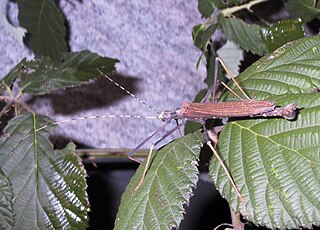
Pseudophasmatidae is a family of stick insect, in the suborder Verophasmatodea, commonly called the "striped walkingsticks". An important identifying characteristic is its mesothorax, which is never more than three times as long as the prothorax.
Malacomorpha is a genus of striped walkingsticks in the family Pseudophasmatidae. There are about 15 described species in Malacomorpha.

Necrosciinae is a subfamily of the stick insect family Lonchodidae, with its greatest diversity in South-East Asia.

Sosibia is an Asian genus of stick insects in the family Diapheromeridae and subfamily Necrosciinae.
The Abrosoma virescens, is a species of phasmid or stick insect of the genus Abrosoma. It is found in Sri Lanka.

Sipyloidea is a genus of stick insects of the family Diapheromeridae. The genus was described by Brunner von Wattenwyl in 1893.
Canuleius is a genus of walkingsticks in the family Heteronemiidae. There are at least 20 described species in Canuleius.

Aschiphasmatidae are a family of stick insects belonging to the suborder Verophasmatodea; they can be found in Indomalaya.
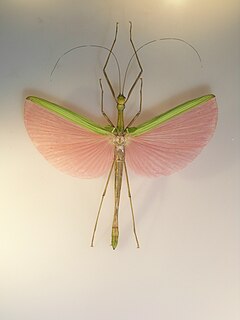
Marmessoidea is an Asian genus of stick insects in the family Diapheromeridae and subfamily Necrosciinae. The native range of species appears to be from India and South-East Asia to the Wallace line.
Oxyartes is a genus of stick insects in the family Diapheromeridae and subfamily Necrosciinae; species records are from India through to Indochina.
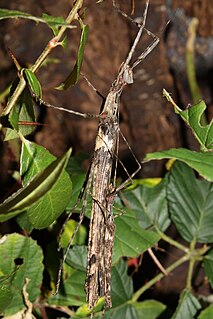
Trachythorax is an Asian genus of stick insects in the family Diapheromeridae and subfamily Necrosciinae. Species have been recorded from the Indian subcontinent, Indo-China, Malesia through to New Guinea.

Necroscia is an Asian genus of stick insects in the family Diapheromeridae and subfamily Necrosciinae. Species have been recorded from South-East Asia.
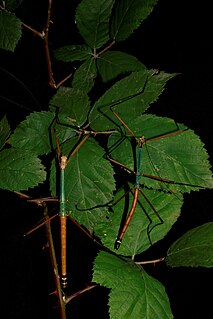
Lopaphus is an Asian genus of stick insects in the family Diapheromeridae and subfamily Necrosciinae. Species have been recorded from India, China and South-East Asia.
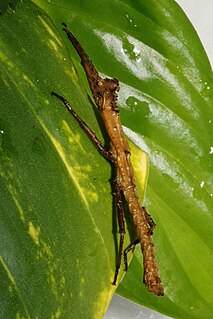
Pylaemenes is an Asian genus of stick insects in the family Heteropterygidae and subfamily Dataminae.

Orestes is a genus of stick insects in the subfamily Dataminae. Species have a known distribution in: Cambodia, Peninsular Malaysia, Singapore, Sumatra, Thailand and Vietnam.

Calvisia is a genus of stick insects in the subfamily Necrosciinae. Species are known to be distributed in temperate and tropical Asia.
Isagoras is a genus of striped walkingsticks in the family Pseudophasmatidae. There are more than 25 described species in Isagoras.

Neoclides is an Asian genus of stick insects in the family Diapheromeridae, subfamily Necrosciinae. Species have a known distribution from: Indo-China, Borneo, Sumatra, Philippines and New Guinea.















